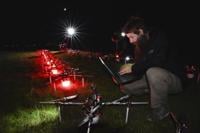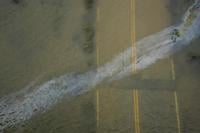BUDAPEST, Hungary (AP) — Moving in a dense cloud, like throngs of people walking across a crowded public square, 100 drones maneuver through the night sky in Hungary's capital, the result of over a decade of research and experimentation that scientists believe could change the future of unmanned flight.
The behavior of the swarm, made up of autonomous drones that make their own real-time decisions on collision avoidance and trajectory planning without pre-programming or centralized control, is guided by research the Hungarian scientists performed on the collective movements of creatures from the natural world.
“It’s very rare that you see some technology and you say it’s beautiful,” said Boldizsár Balázs, one of the researchers working on the project. "In its theoretical core it resembles nature. That’s why the drones themselves don’t need to be pretty, but what they do is pretty because it resembles natural swarming behavior.”
Drones have in recent years become a common sight in our skies: Companies like Amazon and FedEx have launched drone delivery services, hobbyists use them for aerial photography and groups of over 1,000 drones have been pre-programmed to deliver large-scale light shows.
But the scientists at the Eötvös Loránd University in Budapest have developed new models based on animal behavior that allow a large number of drones to travel autonomously, reacting in real time to their environment and each other as they coordinate individual routes and tasks in dense aerial traffic.
“This is the level we call decentralization ... After the drones are told what to do, we can switch off the ground control station, we can burn it or whatever, throw it away,” said Gábor Vásárhelyi, a senior researcher at the university's Department of Biological Physics. “The drones will be able to do what they have to do just by communicating to each other.”
Using data they gathered by monitoring the behavior of pigeons in flight, the patterns of wild horses in the Great Hungarian Plain and other animal movements, they developed an algorithm that allows the drones to make on-board, autonomous decisions, safely mitigating conflicts and avoiding collisions.
While such technology has the potential to increase efficiency across many fields, some researchers have voiced concerns that certain applications of autonomous drones could pose significant dangers.
Anna Konert and Tomasz Balcerzak with the Faculty of Law and Administration at Lazarski University in Warsaw, Poland, have researched such risks, and warn that military applications could escalate arms races or be misused or hacked by malign actors such as terrorist groups.
“When drones take over lethal actions, responsibility may shift from human operators to machines, leading to uncertainty about who should be held accountable if errors occur,” they wrote in an email. “This detachment could lower the psychological barriers to initiating force, potentially making war more frequent and brutal.”
They also write that autonomous drones reducing the human cost of military engagements could “encourage more frequent military actions, leading to faster conflict escalation since fewer immediate human consequences would weigh against the decision to engage militarily.”
But beyond military uses, the researchers in Hungary say their technology has the potential to improve people's lives through numerous other applications.
Their digital simulations in three dimensions have them convinced that their algorithm can be scaled up to support 5,000 drones flying together autonomously, which they say could have applications in meteorology, land surveying, goods deliveries and beyond.
The researchers are also working on rolling out an agricultural application that can be used for the precision spraying of crops, and believe the technology could also play a role in decentralizing air traffic control systems as more and more unmanned aircraft take to the skies.
















































